Germplasm Preservation In Vitro Approaches - PowerPoint PPT Presentation
1 / 13
Title:
Germplasm Preservation In Vitro Approaches
Description:
Importance of germplasm preservation. preservation of ... seeds viability, pathogens, pests ... storage w/o loss of viability. must be economical ... – PowerPoint PPT presentation
Number of Views:1514
Avg rating:3.0/5.0
Title: Germplasm Preservation In Vitro Approaches
1
Germplasm Preservation In Vitro Approaches
- Suggested reading Vasil ch. 9, Bhojwani ch 18
- Importance of germplasm preservation
- preservation of superior genotypes
- preservation of "source material"
- Problems with conventional storage
- conventional seeds viability, pathogens, pests
- vegetatively propagated crops expensive in
terms of labor costs and space needs, esp.
2
Germplasm Preservation In Vitro Approaches
- Potential advantages of in vitro methods
- little space needs
- plants are free of pests, pathogens and viruses
(and will remain so) - no transfer labor (under storage conditions)
- stored cultures can be used as nuclear stock for
vegetative preservation - international shipping restrictions are lessened
- no soil
- pest-free plants
3
Germplasm Preservation In Vitro Approaches
- Basic goals of an in vitro storage system
- to maintain genetic stability
- to keep in indefinite storage w/o loss of
viability - must be economical
- Two types of systems have been developed
- storage in liquid nitrogen (LN) (-196 C)
- cold storage (1-9 C)
4
Germplasm Preservation In Vitro Approaches
- Methods involving LN
- cryopreservation (aka "prefreezing method")
- isolate embryos, establish callus, then
suspension cultures - subculture into fresh medium with a
cryoprotectant (e.g., proline or DMSO) for 3-4 d,
then wash culture - combine chilled culture with incr. conc. of
cryoprotectant
5
Germplasm Preservation In Vitro Approaches
- Methods involving LN
- cryopreservation (aka "prefreezing method")
- transfer to ampoules, then to a controlled
freezing apparatus and cool to -30 C at 1 C per
min. - hold at -30 C for 30 min., then transfer
ampoules to LN (-196 C) - to thaw, take out ampoules and agitate gently in
water at 40 C for 1-2 min. - spread cells on solid medium for regrowth
6
Germplasm Preservation In Vitro Approaches
- Methods involving LN
- vitrification
- use of highly conc. solution of a cryoprotectant
that supercools to v. low temps upon imposition
of rapid cooling rates (and solidification w/o
ice formation) - caution high conc. cryoprotectants can be toxic
- procedure for Brassica campestris
- equilibration of cells at 0 C with 1.5 M
ethylene glycol (EG)
7
Germplasm Preservation In Vitro Approaches
- Methods involving LN
- vitrification
- procedure for Brassica campestris
- equilibration of cells at 0 C with 1.5 M
ethylene glycol (EG) - dehydration in 7.0 M EG 0.88 M sorbitol 6
(w/v) bovine serum albumin (BSA) - transfer of cell suspension into 0.5 ml propylene
straw and quenching in LN - thaw in air 10 s, then 10 s in alc. bath _at_ 20 C
8
Germplasm Preservation In Vitro Approaches
- Methods involving LN
- simple freezing method
- eliminates programmable freezer and use of DMSO
as cryoprotectant - procedure for Citrus
- cells placed in 2 M glycerol and 0.4 M sucrose 10
s at 25 C - 0.2 ml sample is loaded into a 0.5 ml straw and
placed in LN
9
Germplasm Preservation In Vitro Approaches
- Methods involving LN
- simple freezing method
- procedure for Citrus
- thawing is by placing straws into 40 C water
bath - after thawing, cells expelled into 2 ml diluent
containing 1.2 M sucrose in nutrient medium at
25 C - encapsulation-dehydration
10
Germplasm Preservation In Vitro Approaches
- Methods involving LN
- encapsulation-dehydration
- used for storing encapsulated somatic embryos in
Ca-alginate beads - procedure for carrot SEs
- encapsulated SEs precultured in medium with 0.3
to 0.75 M sucrose - dehydration in lam. flow hood 2-6 h followed by
quenching in LN
11
Germplasm Preservation In Vitro Approaches
- Methods involving LN
- cryoselection
- callus of non-hardy spring wheat frozen in LN w/o
cryoprotectants - calli that survived and grew were regenerated
- when rechallenged w/LN, the selected callus lines
survived at much higher rates - seed progeny of some lines exhibited enhanced
tolerance to freezing
12
Germplasm Preservation In Vitro Approaches
- Cold storage
- storage at non-freezing temps, from 1-9 C dep.
on spp. - storage of shoot cultures (stage I or II)
- works well for strawberries, potatoes, grapes,
prob. many more spp. - transferred (to fresh medium) every 6 mo. or on a
yearly basis
13
Germplasm Preservation In Vitro Approaches
- Cold storage
- advantages simple, high rates of survival,
useful for micropropagation (esp. in periods of
low demand) - disadvantages
- may not be suitable for tropical, subtropical spp
because of susceptibility of these to chill
injury - alternative w/coffee shoot cultures transferred
to a medium w/reduced nutrients and lacking
sucrose - requires refrigeration, which is more expensive
than storage in LN































